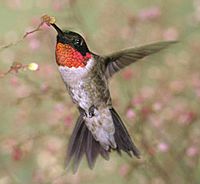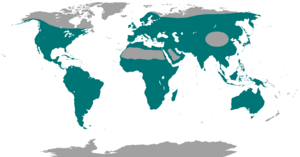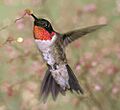Apodiformes facts for kids
Quick facts for kids Apodiformes |
|
|---|---|
 |
|
| Ruby-throated Hummingbird | |
| Scientific classification | |
| Kingdom: | |
| Phylum: | |
| Class: | |
| Subclass: | |
| Infraclass: | |
| Order: |
Apodiformes
Peters, 1940
|
| Families | |
|
Apodidae |
|
 |
|
| Range of the Swifts and Hummingbirds. | |
| Synonyms | |
|
Apodimorphae |
|
Apodiformes is a special group, or order, of birds. This group includes the amazing swifts and the tiny, colorful hummingbirds. These birds are known for their long, narrow wings, which help them fly incredibly well. They also have small, weak feet, which means they don't walk or hop much. Instead, they spend most of their lives in the air!
With almost 450 different species discovered so far, Apodiformes are one of the largest groups of birds. Only the passerines (like sparrows and robins) have more species.
Contents
What Makes Apodiformes Special?
Birds in the Apodiformes order share some unique features that help them live their airborne lives. Their wings are shaped like blades, perfect for fast and agile flight. Unlike most birds, their wing bones are quite short, but their flight feathers are very long. This design allows them to flap their wings in a special way, giving them incredible control in the air.
Swifts: Masters of the Air
Swifts are truly built for flying. They can spend hours, or even days, soaring through the sky without landing. They eat, drink, and even sleep while flying! Their name "swift" perfectly describes how fast and agile they are.
Amazing Flight
Swifts have very long, pointed wings that are perfect for high-speed flight. They can fly incredibly fast, chasing insects in the air. Some swifts can reach speeds of over 100 kilometers per hour (about 60 miles per hour)! They are also very good at changing direction quickly, making sharp turns as they hunt.
Nests and Habits
Because swifts rarely land, their feet are very small and not good for walking. Instead, they use their feet to cling to vertical surfaces like cliffs, chimneys, or walls. They build their nests in these places, often using their sticky saliva to glue materials like twigs, feathers, and even bits of paper together. Both parents help to build the nest and raise their young.
Hummingbirds: Tiny Wonders
Hummingbirds are the smallest birds in the world, but they are also some of the most fascinating. They are famous for their ability to hover in mid-air and fly backward! Their name comes from the humming sound their wings make as they beat incredibly fast.
How They Fly
Hummingbirds have a unique way of flying. Their wings can move in a figure-eight pattern, allowing them to hover perfectly still, fly forward, backward, and even upside down for short distances. Their wings beat so fast that they can be a blur to the human eye – some species can flap their wings over 80 times per second! This amazing flight uses a lot of energy.
What They Eat
To fuel their super-fast wings, hummingbirds need a lot of energy. They get this energy from nectar, a sweet liquid found in flowers. They have long, thin beaks and special tube-like tongues that help them reach deep into flowers to sip the nectar. As they feed, they also help pollinate the flowers, just like bees. Besides nectar, they also eat small insects and spiders for protein.
Where Do Apodiformes Live?
Swifts and hummingbirds can be found in many parts of the world. Swifts live on almost every continent, from Europe and Asia to Africa and the Americas. Many species are migratory, meaning they travel long distances between their breeding grounds and their winter homes.
Hummingbirds are found only in the Americas, from Alaska in the north all the way down to the tip of South America. They live in a variety of habitats, including forests, gardens, and even deserts, as long as there are enough flowers for them to feed on.
Evolution and History
The Apodiformes are an ancient group of birds. Scientists believe they first appeared a very long time ago, possibly during the Paleocene epoch, which was about 66 to 56 million years ago. This means they were around not long after the dinosaurs disappeared! Over millions of years, they evolved their unique flying abilities and specialized diets. Fossils of early swifts and hummingbirds show that their basic body plans haven't changed much over time, proving how successful their design is.
See also
 In Spanish: Apodiformes para niños
In Spanish: Apodiformes para niños
Images for kids


